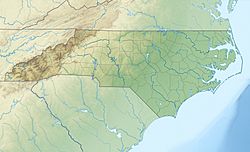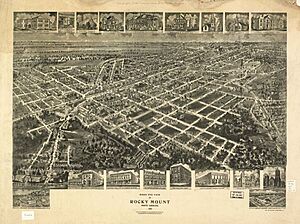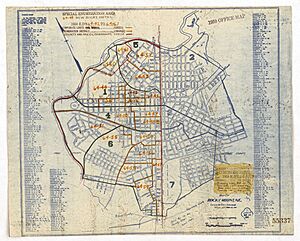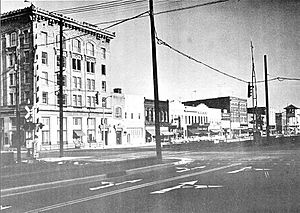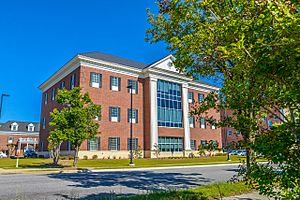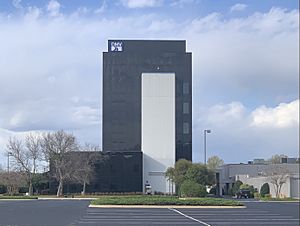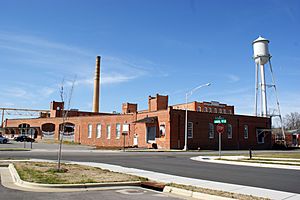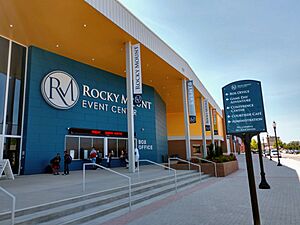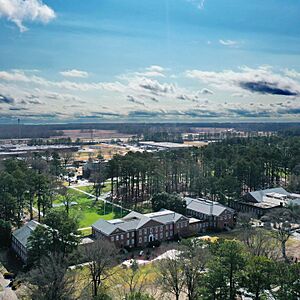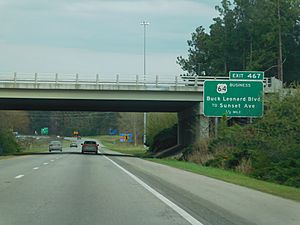Rocky Mount, North Carolina facts for kids
Quick facts for kids
Rocky Mount
|
|||||
|---|---|---|---|---|---|
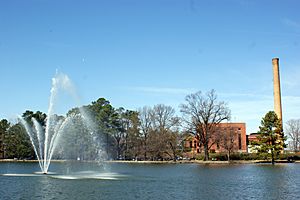
Rocky Mount City Lake Park
|
|||||
|
|||||
| Nickname(s):
City On The Rise
|
|||||
| Motto(s):
"The Center Of It All"
|
|||||
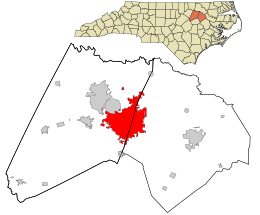
|
|||||
| Country | |||||
| State | |||||
| Counties | Edgecombe, Nash | ||||
| Founded | March 22, 1816 | ||||
| Incorporated | February 19, 1867 | ||||
| Named for | Rocky mounds along the Tar River | ||||
| Government | |||||
| • Type | Council–Manager | ||||
| Area | |||||
| • Total | 44.89 sq mi (116.27 km2) | ||||
| • Land | 44.68 sq mi (115.73 km2) | ||||
| • Water | 0.21 sq mi (0.54 km2) 0.47% | ||||
| Elevation | 85 ft (26 m) | ||||
| Population
(2020)
|
|||||
| • Total | 54,341 | ||||
| • Estimate
(2023)
|
54,245 | ||||
| • Density | 1,216.14/sq mi (469.55/km2) | ||||
| • Urban | 63,297 (US: 432nd) | ||||
| • Urban density | 1,408.0/sq mi (543.6/km2) | ||||
| • Metro | 145,383 (US: 295th) | ||||
| Time zone | UTC−5 (EST) | ||||
| • Summer (DST) | UTC−4 (EDT) | ||||
| ZIP Codes |
27801, 27802, 27803, 27804, 27809, 27815
|
||||
| Area code(s) | 252 | ||||
| FIPS code | 37-57500 | ||||
| GNIS feature ID | 2404643 | ||||
| Interstate Highways | |||||
| U.S. Highways | |||||
| State Highways | |||||
Rocky Mount is a city in North Carolina, a state in the United States. It is located in both Nash and Edgecombe counties. In 2020, about 54,341 people lived there. This makes it the 20th largest city in North Carolina.
Rocky Mount is about 45 miles (72 km) east of Raleigh, the state capital. It is the main city of the Rocky Mount metropolitan area. This area is often called the "Twin Counties." In 2023, about 145,383 people lived in this larger area.
English and Scottish traders first met the native people here in the mid-1700s. The city was officially started in 1867. It grew because of farming (like cotton and tobacco). Factories that made textiles also helped it grow. This was possible because of the water power from the Tar River falls. Railroads also helped connect the town to bigger markets.
Today, Rocky Mount's economy has many different parts. These include making medicines, other goods, and helping with shipping. Rocky Mount has won the All-America City Award twice. It won in 1969 and again in 1999.
Contents
History of Rocky Mount
Early Days and Native People
The area around the Tar River has been home to different groups of indigenous people for 12,000 years. The Tuscarora people, who spoke an Iroquoian language, lived here for a long time. After a war with English colonists in the early 1700s, most Tuscarora moved north. They joined other Iroquoian groups near the Great Lakes.
More English settlers came to the Tar River area. They settled where the land changes from hills to flat plains. This spot, called the fall line, was good because the river's drop could power mills. The Falls of the Tar River Primitive Baptist Church started in 1757. Its records were important for the growing village.
Growth in the 1800s
A post office opened at the Tar River falls on March 22, 1816. This is when the name "Rocky Mount" first appeared. It referred to the rocky area near the river's falls. Soon after, in 1818, Rocky Mount Mills was built. It was the second cotton mill in North Carolina. At first, the mill used the labor of enslaved African Americans. They also worked on cotton farms.
Later, starting in the 1850s, the mill hired only white women and girls to work there. The Battle family, who owned the mill, also helped build a very long railroad. This was the Wilmington and Weldon Railroad. It ran about 2 miles (3.2 km) east of the mill. The railroad connected the area to major ports in Virginia and Wilmington, North Carolina. The first train arrived in Rocky Mount on Christmas Eve in 1839.
The railroad helped the town grow a lot. In 1871, the county line was moved to the middle of the railroad tracks. During the Civil War, in 1863, Union soldiers burned down the mill. It had been making supplies for the Confederate army. After the war, the mill was rebuilt. On February 19, 1867, the village outside the mill, where workers lived, became an official town.
In the late 1800s, the tobacco industry became very important. Rocky Mount was perfect for growing brightleaf tobacco because of its sandy soil. Tobacco also changed the city's social life. Warehouses where tobacco was sold started holding dances in the 1880s. These "june germans" became popular all-night parties. By the end of the 1800s, tobacco was the town's main farm product.
Rocky Mount in the 1900s
Around 1900, Rocky Mount became a main center for the Atlantic Coast Line Railroad. Its large repair shops were built here. This brought many railroad workers to the town. In 1900, Rocky Mount had about 3,000 people. On February 28, 1907, with about 7,500 people, Rocky Mount officially became a city. The railroad, cotton mill, and tobacco farms helped the area grow and do well. A busy downtown area developed.
Like other places in the South, North Carolina had laws that separated people by race. This included where people could live. White neighborhoods grew on the west side of town. Black neighborhoods, like Crosstown, were on the east side. Famous jazz musician Thelonious Monk was born in one of these neighborhoods.
Important Civil Rights events happened in Rocky Mount. In 1946, African-American tobacco workers formed a union. They also worked to help black people register to vote. On November 27, 1962, Martin Luther King Jr. gave a speech at Booker T. Washington High School. He used his famous phrase "I have a dream" a year before his well-known speech in Washington.
After WWII, the city kept growing. In the 1950s and 1960s, the city's economy became more varied. It included banking, manufacturing, and medicine. The fast food chain Hardee's also started its headquarters here.
New colleges were built, like North Carolina Wesleyan College in 1956. Nash Community College and Edgecombe Community College opened in 1968. In 1970, Rocky Mount won its first All-America City Award. In the 1970s, the city's hospitals joined together to form Nash General Hospital. The Rocky Mount–Wilson Regional Airport was also finished around this time.
From the 1980s, the downtown area became less busy. Businesses moved to new shopping centers outside the city, like Golden East Crossing. The city grew by adding nearby areas. For example, in 1996, it added the town of Battleboro. In 1999, the city won its second All-America City Award.
In the fall of 1999, two hurricanes hit eastern North Carolina. Both passed over Rocky Mount. Hurricane Dennis brought 20 inches (510 mm) of rain in August. Hurricane Floyd brought almost 17 inches (430 mm) of rain in September. Floyd caused very bad flooding overnight. Many homes and businesses were destroyed. It was the worst flooding in the history of the Tar River.
Rocky Mount in the 2000s
In the early 2000s, the city worked to make its downtown area lively again. They fixed up buildings like the train station and the Douglas Block. Other buildings, like the Imperial Centre for Arts and Sciences, were given new uses.
In 2007, a company bought Rocky Mount Mills. They are turning it into a place with breweries, restaurants, apartments, and event spaces. New community projects include a 143-acre (58 ha) sports complex. There is also a 165,000 sq ft (15,300 m2) event center downtown. In 2019, CSX started building a new cargo terminal. This is expected to help the local economy grow.
Geography and Climate
Rocky Mount is in northeastern North Carolina. It sits where the flat Atlantic Coastal Plain meets the hilly Piedmont region. The city is 58 miles (93 km) east of Raleigh.
The Tar River flows through the city from west to east. It drops 25 feet (7.6 m) within the city limits. The city is split between Edgecombe and Nash counties. The county line follows the railroad tracks through the city's center.
Historic Rocky Mount Mills Village
The Rocky Mount Mills Village is near the Tar River. It grew in the late 1800s and early 1900s. It was a community for workers at the mill. Houses built between 1885 and 1940 are part of this historic area. They are recognized by the National Register of Historic Places.
When the mill closed, the workers had to find new homes. However, the property stayed mostly the same. Even though the homes have always been rentals, there are rules to protect their history. These rules also help people buy and live in the homes.
Weather in Rocky Mount
Rocky Mount has a humid subtropical climate. This means it has cool, sometimes cold, winters. Summers are hot and humid. Average high temperatures are around 51°F (11°C) in winter. They reach about 90°F (32°C) in summer. Average low temperatures are around 31°F (-1°C) in winter. They are about 69°F (21°C) in summer.
| Climate data for Rocky Mount, North Carolina (1991–2020 normals, extremes 1954–present) | |||||||||||||
|---|---|---|---|---|---|---|---|---|---|---|---|---|---|
| Month | Jan | Feb | Mar | Apr | May | Jun | Jul | Aug | Sep | Oct | Nov | Dec | Year |
| Record high °F (°C) | 78 (26) |
82 (28) |
89 (32) |
96 (36) |
98 (37) |
106 (41) |
105 (41) |
103 (39) |
102 (39) |
101 (38) |
86 (30) |
80 (27) |
106 (41) |
| Mean daily maximum °F (°C) | 50.3 (10.2) |
53.6 (12.0) |
60.9 (16.1) |
71.2 (21.8) |
78.0 (25.6) |
85.3 (29.6) |
88.4 (31.3) |
85.3 (29.6) |
81.3 (27.4) |
72.2 (22.3) |
64.7 (18.2) |
55.0 (12.8) |
70.5 (21.4) |
| Daily mean °F (°C) | 40.5 (4.7) |
42.6 (5.9) |
49.5 (9.7) |
59.3 (15.2) |
67.5 (19.7) |
75.4 (24.1) |
78.9 (26.1) |
76.3 (24.6) |
71.7 (22.1) |
61.0 (16.1) |
51.7 (10.9) |
44.3 (6.8) |
59.9 (15.5) |
| Mean daily minimum °F (°C) | 30.6 (−0.8) |
31.7 (−0.2) |
38.1 (3.4) |
47.3 (8.5) |
57.0 (13.9) |
65.4 (18.6) |
69.3 (20.7) |
67.4 (19.7) |
62.2 (16.8) |
49.7 (9.8) |
38.8 (3.8) |
33.7 (0.9) |
49.3 (9.6) |
| Record low °F (°C) | −8 (−22) |
4 (−16) |
11 (−12) |
25 (−4) |
32 (0) |
43 (6) |
51 (11) |
45 (7) |
37 (3) |
19 (−7) |
16 (−9) |
0 (−18) |
−8 (−22) |
| Average precipitation inches (mm) | 3.22 (82) |
3.00 (76) |
3.85 (98) |
3.54 (90) |
3.63 (92) |
4.81 (122) |
5.10 (130) |
5.28 (134) |
6.15 (156) |
3.55 (90) |
3.20 (81) |
3.23 (82) |
48.56 (1,233) |
| Average snowfall inches (cm) | 1.9 (4.8) |
0.3 (0.76) |
0.2 (0.51) |
0.0 (0.0) |
0.0 (0.0) |
0.0 (0.0) |
0.0 (0.0) |
0.0 (0.0) |
0.0 (0.0) |
0.0 (0.0) |
0.0 (0.0) |
0.4 (1.0) |
2.8 (7.1) |
| Average precipitation days (≥ 0.0 in) | 8.1 | 7.2 | 8.2 | 7.7 | 8.3 | 9.1 | 9.8 | 8.6 | 7.7 | 6.1 | 6.5 | 7.8 | 95.1 |
| Average snowy days (≥ 0.1 in) | 0.5 | 0.1 | 0.1 | 0.0 | 0.0 | 0.0 | 0.0 | 0.0 | 0.0 | 0.0 | 0.0 | 0.1 | 0.8 |
| Source 1: NOAA | |||||||||||||
| Source 2: Weather.com | |||||||||||||
People and Culture
Population and Diversity
| Historical population | |||
|---|---|---|---|
| Census | Pop. | %± | |
| 1870 | 357 | — | |
| 1880 | 552 | 54.6% | |
| 1890 | 816 | 47.8% | |
| 1900 | 2,937 | 259.9% | |
| 1910 | 8,051 | 174.1% | |
| 1920 | 12,742 | 58.3% | |
| 1930 | 21,412 | 68.0% | |
| 1940 | 25,568 | 19.4% | |
| 1950 | 27,697 | 8.3% | |
| 1960 | 32,147 | 16.1% | |
| 1970 | 34,284 | 6.6% | |
| 1980 | 41,283 | 20.4% | |
| 1990 | 48,997 | 18.7% | |
| 2000 | 55,893 | 14.1% | |
| 2010 | 57,477 | 2.8% | |
| 2020 | 54,341 | −5.5% | |
| 2023 (est.) | 54,245 | −5.6% | |
| U.S. Decennial Census 2020 |
|||
In 2020, Rocky Mount had 54,341 people. There were 22,260 households and 14,334 families. Most people in Rocky Mount are Black or African American (63.35%). White people make up 26.63% of the population. Other groups include Asian (1.39%), Native American (0.55%), and people of mixed races (3.11%). About 4.92% of the population is Hispanic or Latino.
The average age in Rocky Mount is 38.7 years. About 27.5% of the people are between 1 and 19 years old. The city's average household income was $37,059.
Religious Life
About 40.3% of people in Rocky Mount are part of a religious group. This is a bit lower than the state average. Christianity is the largest religion. Most Christians are Baptists (13.3%). Other Christian groups include Pentecostals (4.5%) and Methodists (3.5%). Islam is the second largest religion, with 0.5% of the population.
Economy and Jobs
Rocky Mount's economy used to rely on farming and making textiles. Now, it has many different types of businesses. These include companies that make medicines and other goods. Shipping and logistics are also important. This is because the city is near many highways and train lines. There are also many service and financial companies here.
Rocky Mount is about 45 miles (72 km) from Raleigh and the Research Triangle. This area has helped bring new companies to Rocky Mount. These companies look for skilled workers and lower costs for living and doing business.
In 2020, a study found that Rocky Mount was the third-best place in the U.S. for manufacturing. Manufacturing grew by 11.8% between 2014 and 2018. There were 108% more manufacturing jobs here than the national average. In 2019, CSX Transportation started building a large cargo terminal. This $200 million project is expected to boost the local economy.
Top Employers
Here are some of the biggest employers in the Rocky Mount area as of 2018:
| # | Employer | No. of employees |
|---|---|---|
| 1 | Pfizer | 3,200 |
| 2 | Nash-Rocky Mount Public Schools | 2,275 |
| 3 | Cummins–Rocky Mount Engine Plant | 1,800 |
| 4 | Nash UNC Health Care | 1,600 |
| 5 | Edgecombe County Public Schools | 1,100 |
| 6 | QVC Distribution center | 1,100 |
| 7 | CenturyLink | 1,000 |
| 8 | Sara Lee Frozen Bakery | 950 |
| 9 | Alorica | 885 |
| 10 | City of Rocky Mount | 850 |
Shopping Areas
Rocky Mount is a popular place for shopping. It has many large stores and special shops. Most shopping centers are along US 301 (Wesleyan Boulevard). Examples include Golden East Crossing and Englewood Square.
Downtown, the Douglas Block is a business area that used to be a center for African-American businesses. Station Square is another shopping spot near city hall and the train station.
Arts and Entertainment
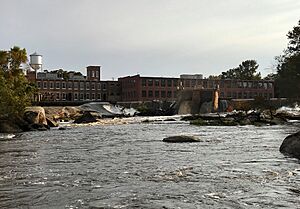
Rocky Mount has many places for performing arts. The Imperial Centre for the Arts and Sciences has an arts center, a Children's Museum, a Science Center, and a community theater. The Dunn Center for the Performing Arts at Wesleyan College hosts college shows and touring acts. It is also home to the Tar River Orchestra and Chorus. The Rocky Mount Event Center downtown can hold up to 5,000 people for shows and sports.
Rocky Mount Mills is a unique place for craft breweries. It was the first of its kind in North Carolina. Many new breweries and restaurants are there now. The mill also hosts summer music festivals and other events. It has been redeveloped since 2014. Nearby, you can find many historic homes for rent in the Rocky Mount Mills Village. The next part of the development is Goat Island on the Tar River. It will have hiking trails, sandy beaches, and places for rafting.
A Rocky Mount Railroad Museum is being planned. The railroad was very important to the city's growth. In the early 1900s, the Atlantic Coast Line Railroad employed over 2,000 people here. The museum hopes to find a good location, possibly inside the train station.
Historic Places to Visit
The Rocky Mount area has many historic buildings and districts. Some individual properties include the Bellamy-Philips House and Rocky Mount Electric Power Plant. There are also several historic districts. These include Edgemont Historic District and Rocky Mount Mills Village Historic District. All of these are listed on the National Register of Historic Places.
Parks and Fun Activities
Rocky Mount is a big center for youth sports tourism. It is a good halfway point between New York and Florida along I-95. The Rocky Mount Sports Complex has seven baseball fields, four softball fields, and eight soccer fields. It also has a disc golf course, basketball courts, and volleyball courts. Many state and interstate tournaments are held here.
The complex also has a football stadium. It is home to the NCWC Battling Bishops football team. The Rocky Mount Event Center has eight indoor basketball courts and sixteen volleyball courts. It also has a ropes course and a climbing wall. It plans to host indoor sports competitions.
The Tar River Trail is a 7-mile (11 km) greenway. It runs along the Tar River and connects to many parks and city landmarks. You can also use boat ramps to go paddling on the river. City Lake Park, built in 1937, is one of the parks. Battle Park is 57 acres (23 ha) and is centered on the falls of the Tar River. The trail also has a 220-foot (67 m) long wooden bridge. It is thought to be the longest such wooden bridge in the U.S.
Education in Rocky Mount
North Carolina Wesleyan University is a four-year private college in Rocky Mount. It has a center for business and entrepreneurship. This center offers free programs to the public. They focus on business development and community involvement.
The city also has Nash Community College. It offers a program in brewing and distillation. This program works with the Mills. Edgecombe Community College has a downtown campus. It specializes in biotechnology and medical simulation. This is one of only two such centers in the state. Shaw University also has a campus in Mills Village.
Most public schools in Rocky Mount are part of the Nash-Rocky Mount Public School System. This system has 15,000 students in 28 schools. Parts of the city in Edgecombe County are served by the Edgecombe County Public Schools system. High schools include Nash Central High School and Rocky Mount High School. There are also special public schools like Tar River Academy. Rocky Mount Preparatory School is a local charter school. There are also several private schools.
Braswell Memorial Library is the main public library for the community. It is part of the NC Cardinal system. This means you can check out books from other libraries across the state.
Media and News
Rocky Mount is part of the Raleigh-Durham-Fayetteville TV and radio market. This is the 25th largest market in the U.S. Some TV stations from the Greenville-New Bern-Washington market also cover the city.
Locally, WHIG-TV and WNCR-LD are Rocky Mount's community TV stations. WRQM 90.9 FM is a public radio station that plays programs from NPR. The Rocky Mount Telegram is the main daily newspaper for the city and nearby areas.
Getting Around Rocky Mount
Roads and Highways
Three major highways serve the city:
 I-95 is to the west.
I-95 is to the west. US 64 (which will become Future I-87) is the main east-west road.
US 64 (which will become Future I-87) is the main east-west road. US 301 (Wesleyan Boulevard) is the main north-south road.
US 301 (Wesleyan Boulevard) is the main north-south road.
Downtown, US 64 Bus. and US 301 Bus. are important roads. State highways like NC 43 and NC 97 connect Rocky Mount to nearby towns.
Airports for Travel
The Rocky Mount–Wilson Regional Airport (RWI) serves the area for general aviation. It is about 9 miles (14 km) southwest of downtown. The closest airport with regular passenger flights is Pitt–Greenville Airport (PGV), 40 miles (64 km) to the southeast. For cargo and charter flights, the Kinston Regional Jetport (ISO) is 50 miles (80 km) south. The larger Raleigh-Durham International Airport (RDU) is 74 miles (119 km) to the west.
Train Services
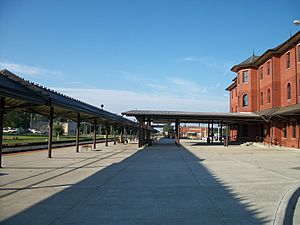
Amtrak provides train service at the Rocky Mount station downtown. There are three trains going north and three going south each day. You can travel to cities like Washington, D.C., New York City, and Miami. CSX provides freight train service. These trains go to places in eastern North Carolina and also to the west and south of the city.
Public Buses
Tar River Transit offers public bus service in and around Rocky Mount. It has 10 bus routes throughout the city.
Famous People from Rocky Mount
Many notable people have connections to Rocky Mount:
- Herman Boone, a coach shown in the movie Remember the Titans, was born here.
- Roy Cooper, the current governor of North Carolina.
- Mike Easley, a former governor of North Carolina.
- Phil Ford, a famous basketball player for UNC and the NBA.
- Jim Gardner, a businessman and politician who helped start Hardee's in the city.
- Kay Kyser, a big band musician and radio star.
- Buck Leonard, a legendary Negro league baseball player.
- Thelonious Monk, a very famous jazz pianist.
- Susie Sharp, the first female justice on the North Carolina Supreme Court.
- Jim Thorpe, an Olympic gold medalist who played minor league baseball here.
- Mary Elizabeth Winstead, an Emmy Award winning actress.
See also
 In Spanish: Rocky Mount (Carolina del Norte) para niños
In Spanish: Rocky Mount (Carolina del Norte) para niños





